This article was co-authored by wikiHow Staff. Our trained team of editors and researchers validate articles for accuracy and comprehensiveness. wikiHow's Content Management Team carefully monitors the work from our editorial staff to ensure that each article is backed by trusted research and meets our high quality standards.
There are 10 references cited in this article, which can be found at the bottom of the page.
wikiHow marks an article as reader-approved once it receives enough positive feedback. This article received 21 testimonials and 93% of readers who voted found it helpful, earning it our reader-approved status.
This article has been viewed 426,023 times.
Learn more...
Increasing the weight of a pig requires giving it the right food. If the pig doesn't gain weight as fast you'd like, you should reduce its fiber intake while adding fat and sugar to its diet. Choosing the right protein and grain sources are also important elements of making your pig gain weight. Beyond making the right dietary choices, keeping your pig healthy and housed comfortably will encourage weight gain.
Steps
Feeding Your Pig Properly
-
1Feed your pig food that is low in fiber.[1] Since fiber takes more energy to digest, the pig will end up expending more calories when eating fiber that it would when eating a less fibrous food. In other words, a high-fiber diet will reduce the amount of calories that the pig absorbs and turns into fat.
- Avoid feeding your pig soy hulls, wheat midds, and distillers dried grains with solubles (DDGS).[2]
-
2Give your pig feeds with a high fat content.[3] Fat in pig feed comes from poultry, pork, tallow, vegetable oils, and blended animal or vegetable fats. The type of fat that is included in your pig’s feed has little impact on the weight gains it will make. Feed your pig whatever high-fat feed that it finds most palatable, and you find most affordable.[4]
- Skim milk, yogurt, and dairy are also foods that can increase pig fat.
- Sweet foods with high sugar content -- donuts, candy, and cupcakes -- can also rapidly increase your pig’s weight.[5]
Advertisement -
3Select a protein source. Tankage (animal feed made from residue left behind from the tanks in which animal carcasses were rendered) and meat scraps are two good sources of protein. Soybean oil meal is another option. Give your pig a mix of many types of protein.[6] See what the pig likes best, and feed it primarily that type of protein.
- Combining soybean meal with a corn diet will provide your pig with well-balanced amino acid levels.[7]
-
4Choose a grain for your pig. Whatever you choose, 50% of your feed should be yellow corn. The remainder of your pig’s feed should be a mix of barley, wheat, and sorghum. Feed your pig various grains and see which it likes best. Use the pig’s favorite grain in abundance in order to increase its weight.[8]
- Avoid bird-proof sorghums, as pigs find them less desirable than regular red or white sorghum.
-
5Increase the amount of food the pig is eating.[9] Weight gain occurs as a result of ingesting excess calories. If a pig is not eating enough food, it will lose weight. If a pig eats over and above the caloric volume needed to maintain its current weight, it will increase its weight.
- Increase the pig’s nutrient intake as you increase the amount of food it eats. Take your pig to the vet or nutritionist for blood work and a nutritional analysis. The vet will be able to tell you if your pig is suffering a nutritional deficiency, and what supplements can correct it.
- Adequate nutrient intake helps your pig absorb calories more efficiently.
- Vitamin B12 is an important addition to your pig’s diet. It can help improve feed intake, as well as reduce stress levels and prevent disease in your pig. B12 injections are the best way to go. Talk to your vet about how much B12 your pig should receive.
-
6Add supplements to the pig’s diet.[10] You can choose to add fat or protein in order to help your pig pack on pounds. Fat and protein supplements (sometimes labeled as energy supplements) are available in many varieties, with fat and protein contents ranging from 30% up to 70% or more. Some have high protein and high fat, while others are high in either fat or protein.
- Decide how much weight you want to increase your pig by, then incorporate fat supplements or fatty foods into the pig’s diet.
- Typically, pigs under 150 pounds receive half a pound to one pound of supplements. For pigs over 150 pounds, you can add one to one and a half pounds of supplements.
- Always follow the directions on the package of your supplement product.
- Young pigs need about 17% of their diet to be protein. Older pigs should get a diet with about 15% protein.[11]
-
7Make the food more appealing.[12] Palatability enhancers are toppings that you apply to your pig’s feed in order to make the food taste better. If your pig enjoys what it’s eating, it will eat more of it, thus increasing its weight. Try several palatability enhancers and see which pushes your pig to eat the most.
- Add water to the feed. When your pig’s feed is wet, the food will be softer and the pig can more easily ingest it. Pour some water over your pig’s feed in order to turn it into a watery mush or paste.
- If your pig really likes one feed, but dislikes another, you should regularly purchase the one it likes. Tasty feed will be consumed in greater quantities and with greater enjoyment than feed that the pig doesn’t like. This will lead to rapid weight gain.
- Give your pig a variety of foods. Like people, pigs get bored of eating the same thing over and over.[13]
Adjusting Your Pig’s Environment
-
1Ensure your pig has enough space.[14] If a pig’s facilities are inadequate for its needs, its appetite will decline due to stress. Pigs should be given between 20 and 50 square feet of space within their pens, and at least 100 square feet of outside pasture in which to move around in.[15] There are several ways to give your pig more space, such as:
- removing pigs from the pen and putting them in a separate, larger enclosure
- selling pigs until you have a population that can thrive within the confines of the pen
- expanding the size of the pig pen
-
2Ensure your pig can access its food. If your pig is having a hard time getting to the feeder or trough, take steps to help it. For instance, if your pig is being fed with several others in a communal pen, it might be pushed aside by larger, more dominant pigs.[16] If you only keep feed out during limited windows of time, some pigs might be eating less than others.
- Consider adding a feeder, or providing extra bowls of feed for pigs that aren’t at the weight they should be.
- Always give your pig fresh water. Even if you add water to your pig’s feed to soften it, you should also provide a bowl or trough for water. Change your pig’s water regularly. Water should be cool but not cold. Pigs need 2-3 pounds of water for every pound of feed they consume.
-
3Regulate your pig’s temperature.[17] If the weather is hot (95 degrees Fahrenheit or above), your pig will be disinclined to eat. Humidity levels as well as temperature affect the pig’s tendency to eat. Low humidity makes pigs more interested in eating.
- Keep the air in your pig pen circulating by opening the windows or doors. Introduce fans or a large inflatable pool into the area your pig lives. Ensure it has plenty of shade.
- Ensure your pig is not too cold. If the temperature of your pig pen is below 60 degrees Fahrenheit, your pig might be too cold to eat. Ensure your pig pen is well-insulated against winter. Use a heater to keep the temperature in your pig pen between 60 and 75 degrees Fahrenheit.
Keeping Your Pig Healthy
-
1Monitor your pig’s health.[18] Sick pigs will not be inclined to eat much. Even when a sick pig does eat, its illness causes nutrients and vitamins to be expended at higher rates than normal as the pig fights off the infection or disease afflicting it.
- Check your pig’s temperature with a rectal thermometer. The temperature should be around 102.5 degrees Fahrenheit.
- If your pig has a fever, take it to the vet immediately.
- Look for signs your pig is ill. If your pig is acting lethargic, squeals painfully, has diarrhea, or does not eat, it may be ill. There could be one or many causes for your pig’s illness, including viruses, parasites, or poor nutrition. Take it to a qualified veterinarian for a checkup.
-
2Deworm your pig.[19] Deworming regularly (every thirty days) will keep your pig healthy and remove the parasites that steal nutrients and calories away from your pig. You don’t need to take your pig to the vet in order to deworm it. Rather, you can purchase a commercial deworming medication at your local farm supply store and administer it directly to your pig. Most require a three-day feeding cycle. Be sure to follow the directions with your pig’s deworming medicine.
- You do not need assistance to administer the deworming medicine. Simply add it to the pig’s feed, typically at a ratio of one cubic centimeter per 50 pounds of body weight. In other words, if your pig weighs 100 pounds, you’ll probably add two cubic centimeters of deworming medicine. However, always use the prescribed dosage when administering any medicine to your pig.
-
3Check your pig for injuries.[20] If your pig has recently had an operation or been injured, it will not want to eat much. Check your pig’s legs and belly for sores, and check its feet for sharp objects. Patch up small wounds. If you see serious injuries, take your pig to the vet as soon as possible.
- You should also bring your pig to the vet before introducing him or her to the rest of your pigs. This will ensure the pig doesn’t introduce parasites or illnesses to the other pigs.
- If you observe any strange behavior such as lethargy, staggering, poor appetite, it may be injured internally or ill. Bring your pig to the vet for an examination.[21]
- Pigs should get a checkup from the veterinarian at least once each year.
Community Q&A
-
QuestionWhy do some feeds have more sand?
 KarinTop AnswererThey shouldn't, no feed should have ANY sand in it. What you'd be looking at is finely ground grains, meant as pig feed. But sand should never be fed to a pig, ever.
KarinTop AnswererThey shouldn't, no feed should have ANY sand in it. What you'd be looking at is finely ground grains, meant as pig feed. But sand should never be fed to a pig, ever. -
QuestionIs rice bran good feed for pigs?
 Community AnswerAny bran is high in fiber, it might give them indigestion and they'll gain less weight.
Community AnswerAny bran is high in fiber, it might give them indigestion and they'll gain less weight. -
QuestionAre there injections to increase my pig's weight?
 Community AnswerYes, dexamethasone and mericyl with multivitamin are the drugs you can administer to increase a pig's weight.
Community AnswerYes, dexamethasone and mericyl with multivitamin are the drugs you can administer to increase a pig's weight.
Warnings
- Ground meal may have a minimum purchase, and could be expensive for a person with a small number of pigs.⧼thumbs_response⧽
- Don’t grow your pig too fast. Hemorrhagic bowel syndrome (HBS) causes death in pigs that grow too fast, and is not understood completely. Including DDGS in your pig’s feed may reduce likelihood of HBS.[22]⧼thumbs_response⧽
References
- ↑ http://www.purinamills.com/animal-nutrition-information/articles/show-animals/increasing-pig-growth-rate-in-show-pigs/
- ↑ http://nationalhogfarmer.com/mag/farming_feeding_early_finishers?page=5
- ↑ http://www.purinamills.com/animal-nutrition-information/articles/show-animals/increasing-pig-growth-rate-in-show-pigs/
- ↑ http://swine.missouri.edu/nutrition/pigfatsource.htm
- ↑ http://www.wellfedhomestead.com/how-to-fatten-pigs-and-people
- ↑ https://www.linkedin.com/pulse/tips-feeding-pigs-increase-weight-roosy-taylor
- ↑ http://www.animalgenome.org/edu/PIH/prod_growing.html
- ↑ https://www.linkedin.com/pulse/tips-feeding-pigs-increase-weight-roosy-taylor
- ↑ http://www.purinamills.com/animal-nutrition-information/articles/show-animals/increasing-pig-growth-rate-in-show-pigs/
- ↑ http://www.purinamills.com/animal-nutrition-information/articles/show-animals/increasing-pig-growth-rate-in-show-pigs/
- ↑ https://www.linkedin.com/pulse/tips-feeding-pigs-increase-weight-roosy-taylor
- ↑ http://www.purinamills.com/animal-nutrition-information/articles/show-animals/increasing-pig-growth-rate-in-show-pigs/
- ↑ https://www.linkedin.com/pulse/tips-feeding-pigs-increase-weight-roosy-taylor
- ↑ http://www.purinamills.com/animal-nutrition-information/articles/show-animals/increasing-pig-growth-rate-in-show-pigs/
- ↑ http://animals.mom.me/much-space-needed-pigs-10934.html
- ↑ http://nationalhogfarmer.com/mag/farming_feeding_early_finishers?page=6
- ↑ http://www.purinamills.com/animal-nutrition-information/articles/show-animals/increasing-pig-growth-rate-in-show-pigs/
- ↑ http://www.purinamills.com/animal-nutrition-information/articles/show-animals/increasing-pig-growth-rate-in-show-pigs/
- ↑ http://www.purinamills.com/animal-nutrition-information/articles/show-animals/increasing-pig-growth-rate-in-show-pigs/
- ↑ http://www.purinamills.com/animal-nutrition-information/articles/show-animals/increasing-pig-growth-rate-in-show-pigs/
- ↑ http://www.farmsanctuary.org/wp-content/uploads/2012/06/Animal-Care-Pigs.pdf
- ↑ http://nationalhogfarmer.com/mag/farming_feeding_early_finishers?page=8
About This Article
To increase the weight of your pig, feed it foods that are high in fat, like skim milk and yogurt. Also, try feeding your pig more food than you normally do every day so it's taking in more calories. If your pig doesn't seem interested in its food, try pouring some water over it, which will make it softer and more palatable. You can also switch up the kind of food you're feeding it to see if it likes something else better. For more tips, like how to adjust your pig's environment so it eats more, keep reading!

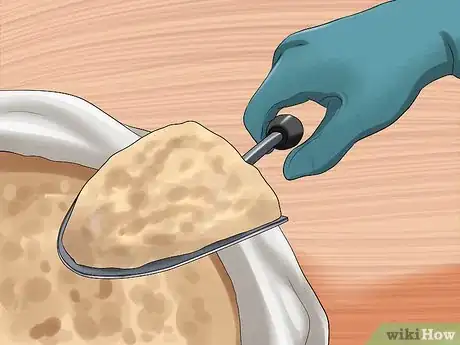
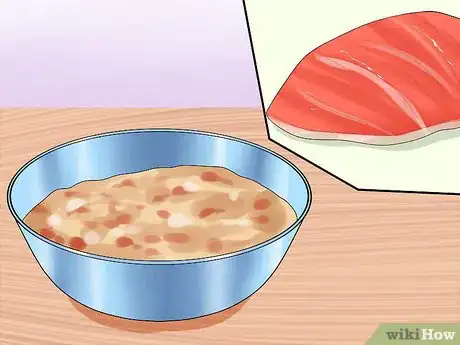

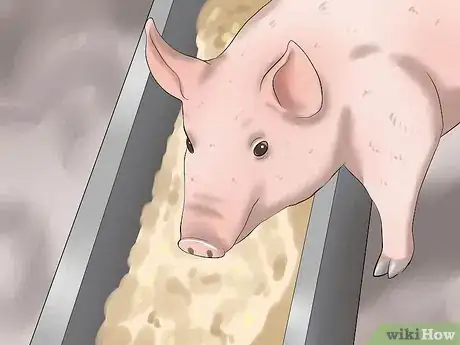
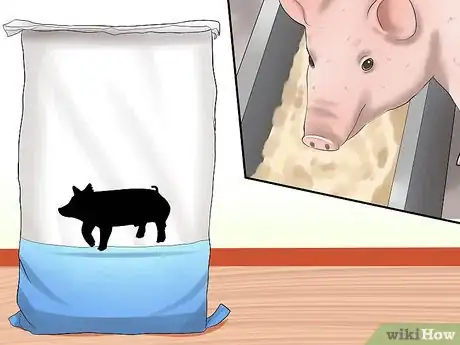
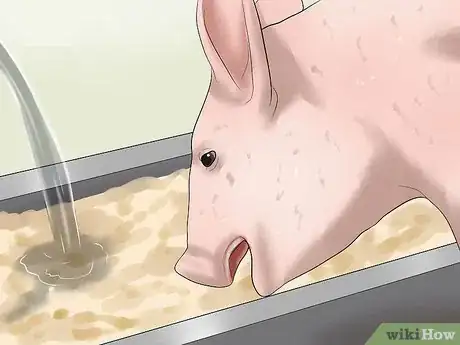


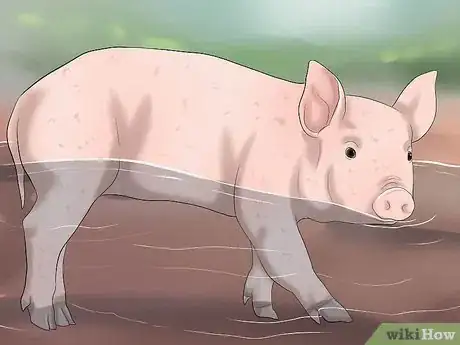
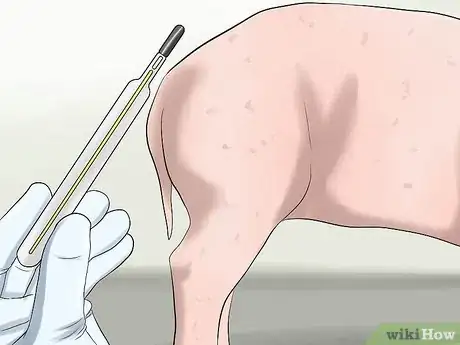
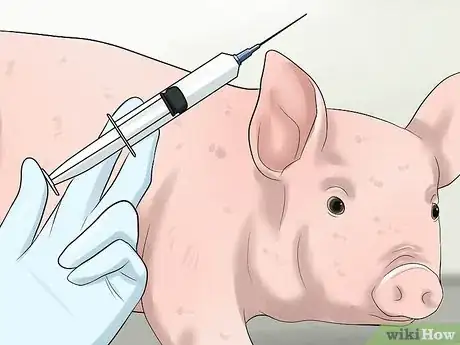
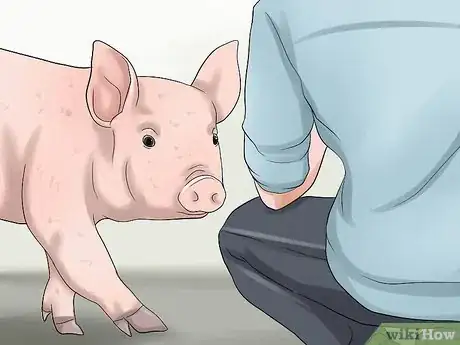
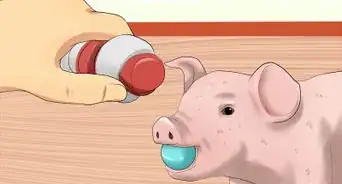







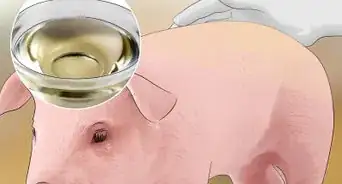


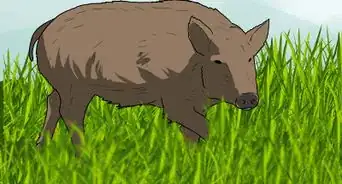












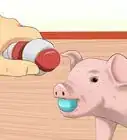







































Medical Disclaimer
The content of this article is not intended to be a substitute for professional medical advice, examination, diagnosis, or treatment. You should always contact your doctor or other qualified healthcare professional before starting, changing, or stopping any kind of health treatment.
Read More...